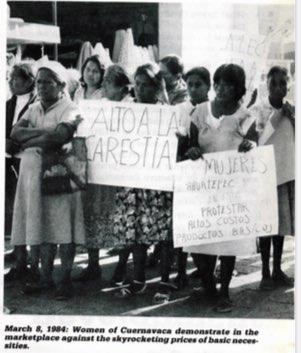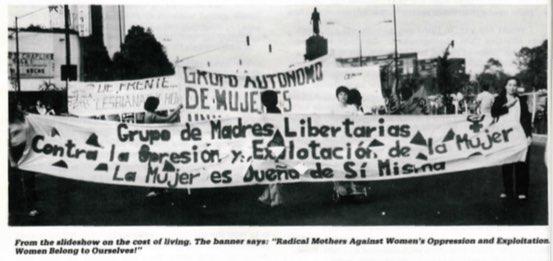CIDHAL/Mexico
CIDHAL, Mexico
Created in 1969 as a Documentation Center on Women, CIDHAL, which stands for Comunicacion, Intercambio y Desarrollo Humano in America Latina (Communication, Exchange and Human Development in Latin America), has widened its activities over the past few years.
Based in Cuernavaca and Mexico City, the CIDHAL team is involved in organizing and popular education with local women's groups, especially in the poor urban areas of the cities. It focuses on women's situations in the family, work, and the community. In the area of health, CIDHAL provides community health services and organizes women's health groups. In all its activities, CIDHAL makes use of audiovisual resources.
In a conversation with Ester Madrid, a member of the CIDHAL team in Mexico, Maria Eugenia Jelincic had the opportunity to learn more about the work of this group and its experience in using audiovisuals as supporting tools in people's education and in organizing women.
- How is CIDHAL helping to organize women in Mexico?
At the moment, we are promoting the organization of two sectors of women. One is that of housewives in the poor urban areas of Cuernavaca and Mexico City. They are a social force needing their own organizations. In the process of organizing, we make a feminist analysis of domestic work, of the repressive context in which our sexuality develops, and of the lack of power women have in the community organizations. Through organizing themselves, the housewives are breaking their isolation, transforming their relationships with their husbands, their children, their neighbors and those in positions of authority in the community. They are beginning to gain a voice and a space in the community organizations.
- With which other sectors do you work?
At the workplace, creating a series of opportunities for women to meet together, not only for political and union education and activities, but also for analysis of their situation as women workers and their specific demands. The women within political and union organizations should provide the leadership and driving force to take up these demands. We are also promoting the creation of mechanisms for coordination to stimulate and reinforce the movement arising in the separate workplaces.
- Which working methods do you use?
Our working methods are based essentially on the analysis of women's daily lives. On reflecting on our "private" problems and collectivizing them in a group. On analyzing the context in which these problems develop so that we can discover and implement possible changes for moving forward.
- What resources or tools do you use to put this process into practice?
We use various kinds of resources to stimulate the dialogue and carry forward the work: flip charts, drawings, theater, role playing, audiovisuals. The CIDHAL team also uses these means to systematize some aspects of the problems which emerge from the discussions and to take them back to the grassroots groups.
- We would like to know more about CIDHAL's experience in using audiovisuals. How would you evaluate this experience?
As very positive, with no doubt at all. Using audiovisuals to motivate and stimulate lets women participate in a more flexible and spontaneous way. In general, audiovisuals arouse more interest, are more entertaining than other means and give people more motivation. Besides, people stay at meetings when there are audiovisuals much more than when there is only discussion about an issue.
- Are there any aspects or issues in this grassroots work for which audiovisuals are particularly useful?
In the area of health, for example, we deal with the most frequent problems of women and children: nutrition, environment, reproduction, sexuality... A good way to approach the issue of sexuality, we have found, is through slideshows. In all the groups we work with, whatever the objectives of the organization, we take up and go more deeply into the subject of sexuality because we have learned the importance of good information for controlling our bodies. In Mexico, women, in general, have little or incorrect information about sex. Middleclass women suffer from the distorted information they are given, from myths and taboos. In the poorer classes, ignorance is the norm. Audiovisuals are very useful in clearing up certain issues, about anatomy and physiology, for instance.
- More useful than other means?
I would say yes. In this case, slideshows are much more effective than photographs or drawings because they come closer to reality and I believe that this allows for greater identification, greater attention to, and greater understanding of the issues.
- Can you tell us about any experiences you have had with this?
There are many, because we use audiovisuals all the time and we are continuously evaluating this work. I will tell you a story which illustrates how far ignorance about our bodies and how they work can go. It is a limited, but eloquent, case. We were showing a slideshow in a poor neighborhood, explaining about the process of childbirth. Afterwards, during the discussion, one of the women said how useful it was for her to see these slides. Before seeing them, she explained, she had never really understood how childbirth takes place. She had once heard that during birth babies come out of the mother through the neck. She thought about this often with disbelief and fear. How could this be possible? She could not figure out how the babies could get up to the mother's neck and get out of it. She even timidly asked a doctor once: "Do babies pass through the mother's neck when they are born?" And the doctor confirmed this without further explanation. "Yes, they pass through the neck."
While watching the slideshow, which clearly showed the female sexual organs and their functions, she finally learned of the existence of the "neck" of the uterus and understood, at last, how childbirth takes place.

- What other experiences can you tell us about the use of audiovisuals?
We have had an interesting experience with the slideshow called Tahur. This has been made in a very simple way: it is a very popular Mexican song with images. The purpose of it is to analyze the machismo of our culture, starting with the deeply macho content of this song. The song is about a gambler who loses everything and finally bets away his wife. People react very indignantly to this, saying that this man has no right to bet away his wife. Many women who react to this audiovisual, ask themselves: "But I like this song a lot and I'm always singing it. Why didn't I ever think about the story it's telling before?" We use this as the basis to go more deeply into the issue of machismo in our culture and about the mechanisms which make it possible in our daily lives.
Another experience which has had very good results is to stop the projection of the audiovisual before it ends so that the women can make up their own conclusion. Audiovisuals with more than one ending are also very stimulating.
- Are there audiovisuals available in Mexico that you can use in your work?
No, in general, the production of educational materials for working with women is not very great in Mexico. In the case of audiovisuals, only CIDHAL and Cine Mujer produce these materials and not very many due to lack of money. We lack financial resources.
- What do you think of the idea of creating a network for the exchange of audiovisual materials with other groups in Latin America? Do you think this would be useful and feasible?
I think it would be very important. In Latin America there are many groups doing similar work with audiovisuals. Even though our situations each have specific problems, they also have many things in common. At present there is no effective exchange of these audiovisuals we have been producing and which reflect our needs, our experiences and our thinking. In CIDHAL, we are very interested in knowing if other groups have audiovisuals we can use. I think that the least we can do is try to find the means to know what has been produced in other places and promote an effective exchange of these resources. With this information, we could save work, time and money.
- What kind of projection equipment do you have access to; that is, what kind of audiovisual resources are you able to use?
In our area it is easy to get hold of carousel type slide projectors and 16 mm film projectors.
- What kind of audiovisuals do you produce and how do you choose the themes?
We produce slide-tape shows. This is a simple type of media within our capabilities. We get good results from them. As far as the content goes, we choose the themes according to the needs we meet in the groups. These themes emerge in dialogue with the grassroots groups. Later we go more deeply into them through interviews. Then a CIDHAL team works out the theme, writing the script and taking the photographs. We often give this script and the slides to specialized people to make the audiovisual, but recently we have been developing our own capacities so that we will be able to make the slideshows entirely ourselves, at CIDHAL.
- Other groups, in Latin America especially, incorporate the production of audiovisuals into the educational process of the grassroots groups themselves. In reflecting upon and going more deeply into the issues, these groups, which have many illiterate women, are appropriating a language for themselves. What do you think of these experiences?
I think they are very interesting. Developing this ability means that these women will be able to repeat the same process later. I think that it must be very stimulating for them to produce their own audiovisuals based on their interests and needs. It is important for grassroots women to learn to produce and manage these resources and not have to depend on specialists to communicate with each other.


